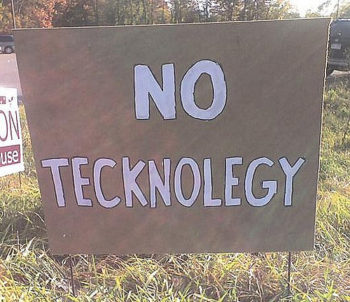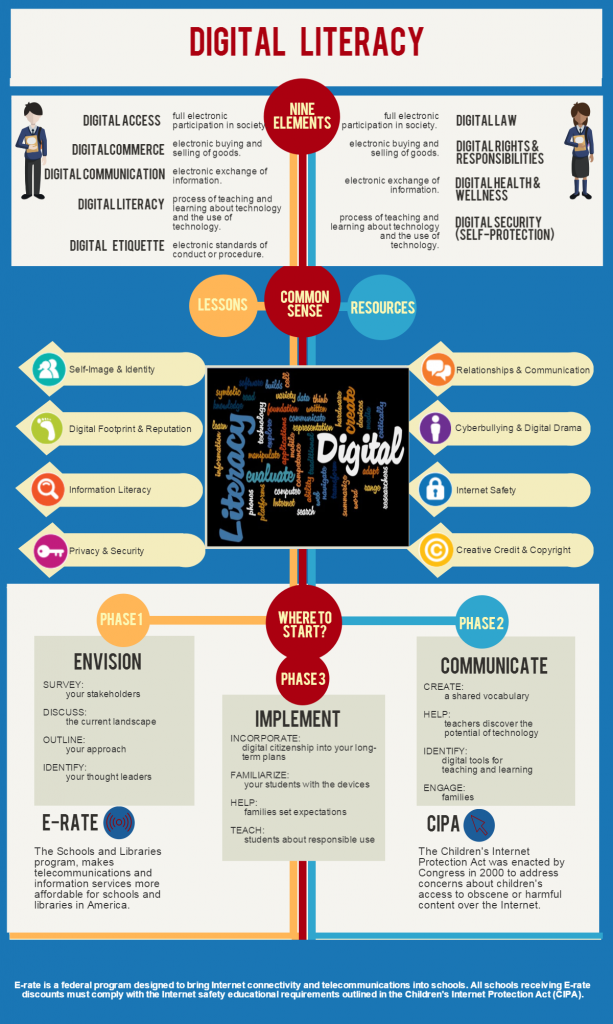
During this, the first class of my Digital Education Leadership program, we looked at the idea of “Digital Readiness” as it pertains to our districts. The basis for our assignment resides in the ISTE Coaching Standard 5 – Digital Citizenship. By reviewing the Digital Readiness of my district I was able to look at the existing status of Digital Literacy in our schools, the changes in our district personnel and processes, and was able to suggest options that would help in the implementation of a new technology plan.
REPORT:
Michelle Lewis, Curriculum and Instruction Services Officer for the Sumner School District graciously accepted my request for an interview in regards to our Sumner School Districts Digital Readiness. I have  summarized where Sumner is currently, in order to examine the next steps, in addition to assisting in the Technology Plan revision. I have included the current initiatives in addition to technology deployments that will be fulfilled in the near future.
summarized where Sumner is currently, in order to examine the next steps, in addition to assisting in the Technology Plan revision. I have included the current initiatives in addition to technology deployments that will be fulfilled in the near future.
Having the status of a technology rich district with the highest, (or one of the highest) student to device ratio, as a small district is a substantial accomplishment possibly providing us with additional opportunities. As part of the previous technology bond, implementation of 1-to-1, Chromebook’s for the high schools will be implemented at the beginning of next school year. Wi-Fi access for students and schools continues to be expanded into the community therefore, students will have access even in downtown Sumner. Currently, the district technology support structure has included an Instructional Technology Coordinator position at each school, two at each high school. These positions are to support and train the teachers on the implementation of technology into the curriculum.
The Common Sense Education’s K-12 Digital Citizenship Curriculum is being implemented in a few of our Elementary schools as an unofficial pilot. A component of your role will be to create a common vision of what quality integrated technology looks like, an exciting task. With all these opportunities, a strategy for implementation and support needs to be created. I have reviewed my interview questions, also your responses, compiling several ideas that may address the needs of the district or provide direction. Defining Digital Citizenship is a good place for us to start.
Digital citizenship can be defined as the norms of appropriate, responsible behavior with regard to technology use. (Ribble)
During the interview we discussed the nine elements that Ribble has defined:
- Digital Access: full electronic participation in society.
- Digital Commerce: electronic buying and selling of goods.
- Digital Communication: electronic exchange of information.
- Digital Literacy: process of teaching and learning about technology and the use of technology.
- Digital Etiquette: electronic standards of conduct or procedure.
- Digital Law: electronic responsibility for actions and deeds
- Digital Rights & Responsibilities: those freedoms extended to everyone in a digital world.
- Digital Health & Wellness: physical and psychological well-being in a digital technology world.
- Digital Security (self-protection): electronic precautions to guarantee safety.
What is Digital Citizenship?
The implementation of these nine elements begins in kindergarten and should be maintained throughout their school experience. Common Sense provides curriculum for the concepts which are grouped into REP’s (Respect, Educate and Protect), Ribble suggests the progression as follows:
Respect Yourself/Respect Others
– Etiquette
– Access
– Law
Educate Yourself/Connect with Others
– Literacy
– Communication
– Commerce
Protect Yourself/Protect Others
– Rights and Responsibility
– Safety (Security)
– Health and Welfare
Common Sense Education has a resource for Districts who have implemented 1-to-1, the best place to start is with the teachers, which aligned with the 3 stages of implementation that they recommend. Because of the work that has been done, most elements have been completed for the technology purchases in Phase 1: Envision. The community was surveyed, a technology bond passed. Currently the purchases and installation of devices with a support structure, are still being implemented. One part of phase 1 that needs to be re-assessed will be identifying the “thought leaders”, with the retirement of Sandy combined with your new position, the focus has changed and the implementation strategy needs to be reviewed, maybe modified.
- SURVEY your stakeholders
- DISCUSS the current landscape
- OUTLINE your approach
- IDENTIFY your thought leaders
Sumner most likely is in phase 2, currently helping teachers discover the potential of technology. While giving suggestions on the technology uses, the strengths and weakness of the tools have not been identified to address learning standards or outcomes.
- CREATE a shared vocabulary
- HELP teachers discover the potential of technology
- IDENTIFY digital tools for teaching and learning
- ENGAGE families
Initially the SAMR (Substitute, Augmentation, Modification, Redefinition) model was introduced through optional district training, but training should be expanded to the entire staff. The creator, Dr. Puentedura founded a consulting firm, Hippasus, which hosts his blog, http://hippasus.com/blog/, includes presentations in addition to many other resources. If it is decided that the SAMR model is the guide, a shared vocabulary providing an understanding of the four pillars, would be an initial step. He also has a noteworthy presentation on Designing for Growth that discusses PCK (Pedagogy, Content, Technology) and EdTech (associated practices).Communicating the best strategies, possibly initiating the discussion is a way in which a common vocabulary can be created, as well as an understanding of Digital Citizenship. With these in place, collaboration across content areas and grade levels could be implemented.
Training will be difficult. The district at this time, is implementing Habits of Mind, Explicit Instruction, Social-Emotional Learning, however each building implements these all with different strategies. Also approaching fast is the initial deployment of 1-to-1, our communication and connection to the students and families should begin.
In a way, phase three has a few components that have already completed. Sumner has integrated the technology as classroom sets, the students have become familiar with them, but responsible has not really been taught. The 1-to-1 implementation document on the Common Sense Education website has extensive resources, to help with teaching responsible use, including Family Media Agreements and Customizable Device Contracts. The education around this will be, in my opinion, the basis for its success, nevertheless details should not be missed.
- INCORPORATE digital citizenship into long-term plans
- FAMILIARIZE r students with the devices
- HELP families set expectations
- TEACH students about responsible use
In conclusion, as suggested, visiting districts that have a model and successful 1-to-1 system in place is a great way to understand where to focus resources. The Kent School District has online resources documenting best practices, and the THE Journal (Transforming Education through Technology) lists best practices, a handful from 1-to-1 Pioneers. Visiting successful programs is a fantastic idea, fortunately the Kent School District exists in our backyard, and visiting with Summit Charter should be explored.
Creative Poster:
Bibliography
1-to-1 Essentials Program | Common Sense Media. (n.d.). Retrieved November 23, 2015, from https://www.commonsensemedia.org/educators/1to1
Puentedura, Ruben R. SAMR and TPCK: An Introduction. Ruben R. Puentedura’s Weblog. 20 Mar. 2013. Web. 29 Mar. 2013. http://www.hippasus.com/rrpweblog/archives/2013/03/28/SAMRandTPCK_AnIntroduction.pdf
Ribble, M. (2015). Nine Elements. Retrieved November 23, 2015, from http://www.digitalcitizenship.net/Nine_Elements.html
Kent School District: Research and Best Practices. (n.d.). Retrieved November 20, 2015, from http://www.kent.k12.wa.us/Page/3381
Meyer, L. (2014, August 14). 7 IT Best Practices for 1-to-1 Districts — THE Journal. Retrieved November 20, 2015, from https://thejournal.com/articles/2014/08/14/7-it-best-practices-for-1-to-1-districts.aspx
What is Digital Citizenship? (n.d.). Retrieved December 10, 2015, from https://www.youtube.com/watch?v=oCkTmZ0bF5Q


